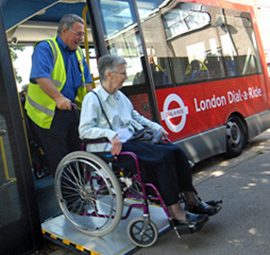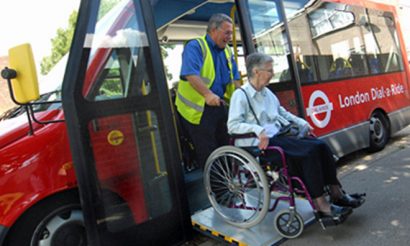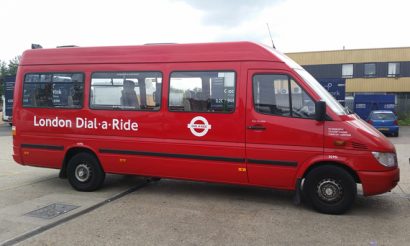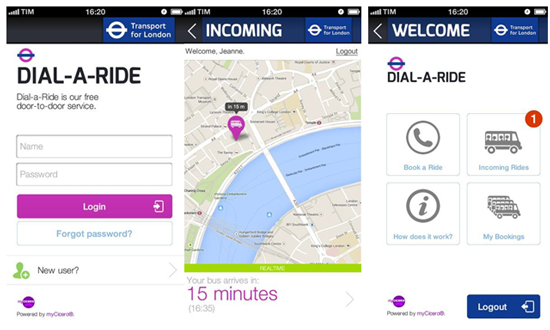EU-wide service platform MOBiNET improves efficiency of Dial-a-Ride service in London
- Like
- Digg
- Del
- Tumblr
- VKontakte
- Buffer
- Love This
- Odnoklassniki
- Meneame
- Blogger
- Amazon
- Yahoo Mail
- Gmail
- AOL
- Newsvine
- HackerNews
- Evernote
- MySpace
- Mail.ru
- Viadeo
- Line
- Comments
- Yummly
- SMS
- Viber
- Telegram
- Subscribe
- Skype
- Facebook Messenger
- Kakao
- LiveJournal
- Yammer
- Edgar
- Fintel
- Mix
- Instapaper
- Copy Link
Posted: 25 August 2016 | Maria De Rycke – ERTICO – ITS Europe, Guido Di Pasquale – Pluservice, Isran Shaffi – Transport for London | No comments yet
The MOBiNET project envisages a new “Internet of Mobility” where transport users meet providers of next-generation mobility services… This article showcases the platform’s implementation within the Dial-a-Ride service improving its efficiency through mobile technology.




The MOBiNET project envisages a new “Internet of Mobility” where transport users meet providers of next-generation mobility services. MOBiNET is a European e-market place of mobility services for business and end users. The MOBiNET platform will enable the implementation of innovative service providing elderly travellers and/or with disabilities with a transport service focused on mobile technology, linking passengers, drivers of Dial-a-Ride (DaR) service and traffic manager. This innovative service will solve the inefficiency of vehicles waiting around for a pick-up, with a clear impact on passive traffic and the needs of passengers, especially elderly or infirm.
DaR is provided by Transport for London (TfL) to users with permanent or long term disability or those who are unable to use the mainstream public services.
At present, there are a lot of delays as the driver reaches the destination and has to wait for the traveller to get ready to board. MOBiNET provides service and application to DaR users with confirmation of expected time of arrival (ETA) of the vehicle for their pick-up and drop off.
Dial-a-Ride MOBiNET enhancement trial in London
The DaR service enhanced by MOBiNET was illustrated in a London pilot site trial that ran for one month (27 October to 27 November 2015).
The London pilot demonstrated the ability to link different sections of the journey together using mobile based applications. The pilot included 3 London boroughs (Lambeth, Merton and Wandsworth) serviced by Wimbledon depot where the trial was operated from.


TfL was responsible for running this pilot with the support from Pluservice, their MOBiNET consortium partner who provided the software, mobile application and hosted the in-station. ETA, DaR end-user App and system integration were provided by Pluservice. MOBiNET provided the ability to test the developments and use the service in real-time environment by end users.
Upon analysing the data, the project team concluded that the software provided by Pluservice sent SMS to the customers with mobile phones 10 minutes in advance and TTS 5 minutes in advance of the pickup time. This has allowed the customers to be ready on time as the results show that the customers were picked up either on time or within accepted tolerance of the pickup time thus improving efficiency. The survey conducted with customers after the trial show a large percentage of the customers were very satisfied in receiving the alerts in the form of SMS and/or TTS.
The approach around the use of personal customer data was in accordance with TfL’s information management and data protection policies.
Dial-A-Ride as MOBiNET enabled innovative and green service
MOBiNET provides a portal dedicated to service providers to manage all aspects of their services and a corresponding end user market for MOBiNET applications. The MOBiNET framework lets service providers sell their services and enable them to easily compose new services to quickly react on changing market demand.
To support a proper migration of existing services, the functionalities of MOBiNET are accessible via dedicated APIs for mobile application and service developers.
MOBiNET is decomposed into six top-level subsystems: Service Directory, Identity Manager, Billing, Dashboard, TSP Manager and MOBiAgent, which basically targets mobile devices of end users.
The vehicles have an on board device that receives alerts about user requests. It then runs a geo-location awareness routine that links to the MOBiNET platform and which in turns passes information via text when the vehicle is within a defined window of arrival. This will help enormously the movement of traveller to vehicle as they will have advance notice of arrival and told to be ready for pick up. The device on board is passing information about its location, its destination, etc, to the traffic management control via MOBiNET. This in turn could potentially feed into a differential priority system, allowing for quicker transit through traffic junctions. The information on vehicle location and speed can be used to help model traffic flow around London, and to validate existing traffic flow models, helping to improve TfL’s ability to monitor and manage traffic around London.
Furthermore the estimated time of arrival (ETA) alerts could be re-used a SaaS (Software as a Service) used by future Apps to inform shops of an imminent delivery arrival. The ETA is published in the MOBiNET Service Directory to be used by App developers for innovative Apps. In the pilot this service is being developed by Pluservice and used to alert customers via a mobile App and via traditional means such as: text message, email, automatic phone call.
Basic features of the MOBiNET platform, such as the Service Directory, Identity Manager, MOBiAgent, Dashboard and Billing, enable the enrichment of this service and enable third party App developers to create new Apps.


Figure – Interaction with MOBiNET
The ETA can be published on the Service Directory, via an online service, such as a Web Service. The input will include the origin, destination and position of the DaR bus; and an output will be the ETA.
There is an opportunity for other applications to benefit from this functionality by accessing the ETA service via the Service Directory. To achieve this, there is a need to:
- develop the Driver Android App using the estimated time of arrival service available on the Service Directory;
- take advantage of the Billing component to charge business2business users for the usage of estimated time of arrival service;
- develop the End-User Dial-a-Ride App making use of MOBiAgent and Identity
- Manager components;
- Interact with the Dashboard and Service Development Toolkit (SDK) for development and management of the services and Apps.
Dial-A-Ride customer’s App
The information on the ETA to the end user is dispatched also through a mobile Application.
The application is developed making use of the MOBiAgent and Identity Manager facilities of MOBiNET. MOBiAgent is used to search for the application and connect to the MOBiCENTRE; the Identity Manager gives the opportunity to the DaR customers to log in to the application through the MOBiNET single sign on system.


Figure – Dial-A-Ride Customer’s App
The application provides the customer with the information on the position of the Bus on the map and the ETA.
On MOBiNET:
- Join the MOBiNET Provider Community (http://mobinet.eu/?q=content/provider-community): you will be among the first providers invited to test the platform and shape its future services.
- Follow MOBiNET on Twitter @MOBiNET_EU
- Join the MOBiNET “the Internet of (Transport and) Mobility LinkedIn Group
|
More information contact MOBiNET Communication Manager: Maria De Rycke, [email protected] |








